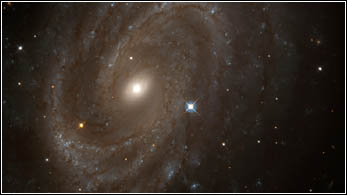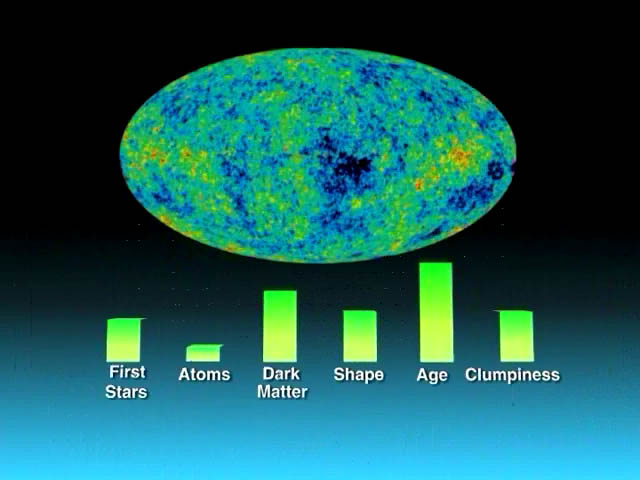Then vs. Now:
The Age of the Universe
Before 1999, astronomers had estimated that the age of the universe was between 7 and 20 billion years. But with advances in technology and the development of new techniques we now know the age of the universe is 13.7 billion years, with an uncertainty of only 200 million years. How did this come to be?
Early estimates of the Age of the Universe
In the 1920's Edwin Hubble discovered the expansion of the universe. He found that galaxies which are further away are moving at a higher speed following the law, v=Hod, where v is the velocity in km/s, d is the distance in Mpc, and Ho is the Hubble constant in km/s/Mpc. By independently measuring the velocity and distances to galaxies, the value of Ho could be determined. Astronomers further determined that the age of the universe is related to Hubble's constant, and that it is between 1/Ho and 2/3Ho depending on cosmological models adopted. The velocity could be determined via the redshift in the spectrum. The distance to the galaxy can be determined using observations of certain types of pulsating stars, called Cepheids, whose instrinsic brightness is related to the period of their brightness variation. However, the accuracy of the distance measurement was hampered by how faint ground based telescopes could see. Up until the 1990's, the best estimates for Ho were between 50 km/s/Mpc and 90 km/s/Mpc, giving a range on the age of the universe between 7 and 20 billion years.
Enter the Hubble Space Telescope
So in 1993, the orbiting Hubble Space Telescope began a "key project" to obtain distances to the Cepheids in 18 galaxies. Astronomers were able to obtain for the first time more precise distances, and a more accurate value of Ho. In 1999 after several years of observations with HST astronomers were able to estimate Ho to be 71 km/s/Mpc within 10% uncertainty, one of the greatest achievements of modern astronomy. Extrapolating back to the Big Bang, that value of Ho implied an age between 9 and 14 billion years old.

(Credit: Jeffrey Newman (UC Berkeley) and NASA)
A New Approach using WMAP
In February 2003, the WMAP project released an all-sky map of the radiation emitted before there were any stars. This cosmic microwave background radiation (CMB) is the remnant heat from the Big-Bang and was predicted already in 1946 by George Gamow and Robert Dicke. Since then, astronomers have tried to detect and interpret the CMB. The first detection of the CMB was found in 1965 by chance by Arno Penzias and Robert Woodrow Wilson using a radiometer built to detect astronomical radio signals. They found an excess in their measurements which was later interpreted as the CMB, a 2.725 kelvin thermal spectrum of black body radiation that fills the universe. In 1992, the satellite Cosmic Background Explorer (COBE) which was designed to map the CMB showed for the first time large scale fluctuations in the CMB. These fluctuations were interpreted as evidences of what later formed clusters of galaxies and voids. However, only WMAP had the resolution and sensitivity to detect tiny fluctuations and constrain the age of the universe with high precision. The WMAP team's results are based on the underlying model used to fit their data. This model assumes that 70% of the energy of the present universe is in the form of dark energy, 26% of the energy is in the form of cold (not thermalized) dark matter, and the remaining 4% of the energy is in the atoms and photons. According to their estimates the universe is 13.7 billion years old with an uncertainty of 200 million years. The WMAP value of Ho is 71 ± 4 km/s/Mpc which is in agreement with the HST key project.

Another approach
Another way of obtaining the age of the universe is by dating stars. Some of the oldest stars live inside globular clusters and their ages have been extensively estimated in the past decade. For a while, astronomers were puzzled by the fact that those stars seemed to be a few billion years older than the age of the universe estimated from the Hubble constant. Is there a problem with Ho or with the cluster's age? It turned out that age dating of globular clusters stars is very tricky and inaccurate distances to the clusters, as well caveats in stellar evolution, can solve the mystery. The age of clusters is proportional to one over the luminosity of the RR Lyra stars which are used to determine the distances to globular clusters. Therefore, accurate distances were needed and could only be obtained after the European Hipparcos satellite in the mid-90s. By using the new distance estimates, the age of the clusters fell from 15 billion years to 11.5 billion years with an uncertainty of about 1 billion year. These results agree with the age of the universe from both the Hubble constant and WMAP.
10th Anniversary Articles
Additional Links
As part of the series, we also published a number of retrospectives on Imagine the Universe!
Publication Date: May 2006


